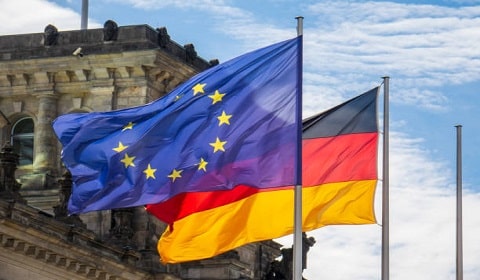
Europe's Economic Performance in 2024: Insights & Forecasts
Europe’s economic performance reflects a complex narrative of struggle and resilience. Despite enduring economic upheavals spanning over a decade, including the European debt crisis and the Covid-19 pandemic, Europe faces the challenge of underperformance in 2024. Germany, the continent’s economic powerhouse, grapples with energy price surges and policy shifts, while France and Italy navigate fiscal deficits and debt burdens.
Yet, amidst these challenges, hope emerges from Central and East European economies outperforming their Western counterparts. Southern Europe shows signs of catching up, and Germany’s historical resilience offers optimism. Effective leadership and geopolitical shifts could catalyze a turnaround, hinting at brighter prospects beyond the current uncertainties.
Europe’s Economic Performance in 2024
In 2024, Europe finds itself at a pivotal moment, marked by economic turbulence spanning the past decade and a half. Despite enduring challenges such as the European debt crisis, the Covid-19 pandemic, and geopolitical tensions like Russia’s Ukraine invasion, Europe’s economic performance remains on shaky ground.
However, there are discernible nuances and potential pathways for recovery. With a closer examination, opportunities emerge for Europe to navigate through its current predicaments and strive towards economic stability. As the continent grapples with multifaceted issues, strategic approaches could steer Europe towards a more resilient and prosperous future.
Here are six key insights and forecasts regarding Europe’s economic performance in 2024:
Table of Contents
1. German Economic Challenges
In 2024, Germany, known as the powerhouse of the European economy, encounters formidable challenges. The nation grapples with the impact of soaring energy prices and China’s economic deceleration, resulting in significant setbacks. Compounding these issues is Germany’s divergence from the market-oriented reforms initiated by former Chancellor Gerhard Schröder, which has diminished its economic robustness.
While forecasts cautiously suggest Germany may avoid a recession, the outlook remains uncertain, casting a shadow over Europe’s economic performance as a whole. This confluence of factors underscores the fragility of Germany’s economy and highlights its pivotal role in shaping Europe’s economic trajectory amidst challenging global conditions.
Read More: First 25 Years of Euro: A Comprehensive Analysis
2. Mixed Fortunes in France and Italy
Europe’s economic performance showcases a nuanced picture, with France demonstrating a steadier course than Germany. Nevertheless, France grapples with a significant fiscal deficit amid the backdrop of escalating global real interest rates, necessitating a potential tightening of economic policies. In contrast, Italy, overcoming years of productivity stagnation and debt woes, displays promising growth and an upward trajectory.
This disparity in fortunes among pivotal European economies adds layers to the intricate economic aspects. France’s economy, while relatively stable, faces pressures amidst broader European economic performance, highlighting the complexities and challenges intertwined within the region’s financial dynamics.
Read More: The Irony of American-Chinese Economic Relations
3. Central and East European Growth
Central and East European economies are emerging as beacons of hope amidst Europe’s economic performance, surpassing their Western counterparts. Notably, Poland has eclipsed Greece and Portugal in real GDP per capita, marking a remarkable feat. Despite persistent challenges such as exchange-rate fluctuations, these economies are poised to make substantial contributions to Europe’s economic revival, particularly in 2024 and beyond.
Their resilience and growth potential signify a positive trend for the continent’s overall economic scenery. As these nations continue to demonstrate robust performance, they offer promising prospects for bolstering Europe’s economic growth trajectory in the foreseeable future.
Read More: Japan’s Economic Recession: A Threatens to Global Market
4. Southern Europe’s Potential
Since 2020, Southern European nations like Spain, Portugal, and Greece have outpaced Northern Europe in economic growth. This divergence in Europe’s economic performance highlights a notable trend. Fueled by thriving tourism sectors and reduced reliance on manufacturing, these countries exhibit promising signs of sustained recovery.
The vibrant tourism industry and diversified economic activities contribute significantly to their upward trajectory. This shift underscores a potential reconfiguration of Europe’s economic outlook. As Southern Europe gains momentum, it not only signals a resurgence but also presents opportunities for broader regional development. With a blend of factors at play, Southern Europe emerges as a beacon of hope amidst the complexities of Europe’s economic dynamics.
Read More: Global Banking Turmoil: A Global Financial Crisis
5. Resilience of the German Economy
Despite facing recent challenges and policy shifts, prematurely betting against the long-term resurgence of the German economy may be unwise. Throughout history, Germany has showcased resilience and adaptability, hinting at the potential for a course correction and a renewed focus on constructing high-quality infrastructure. Such measures could significantly enhance Europe’s economic performance.
Germany’s ability to bounce back from adversity and its commitment to innovation suggest that it’s too early to dismiss its economic potential. By leveraging its strengths and addressing current obstacles, Germany could play a pivotal role in bolstering not only its own economy but also contributing to the broader improvement of Europe’s economic prospect.
6. Political Dynamics and Fiscal Integration
As Europe prepares for upcoming elections, there’s palpable anticipation for potential shifts in leadership. The prospect of new faces at the helm brings hope for addressing pressing economic challenges. Europe’s economic performance hangs in the balance, awaiting effective governance to navigate turbulent waters.
Additionally, looming geopolitical tensions, like the specter of a Russian victory in Ukraine, cast a shadow of uncertainty. However, amidst these challenges lies an opportunity for unity. The threat could serve as a catalyst, propelling European nations towards deeper fiscal integration. Such cooperation promises not only to mitigate risks but also to bolster Europe’s economic resilience through strengthened ties among member states.
Bottom Line
In conclusion, while Europe’s economic outlook for 2024 appears subdued, there are glimmers of hope and potential avenues for recovery, including Europe’s economic performance. Central and East European growth, Southern Europe’s resilience, the potential resurgence of the German economy, and political dynamics could collectively contribute to Europe turning its situation around.
Despite the challenges, European stock markets could witness a rebound, offering investors opportunities amidst lower valuations compared to the US. As history has shown, economic trends are not immutable, and with prudent policies and effective governance, Europe could see brighter economic prospects in the near future.





